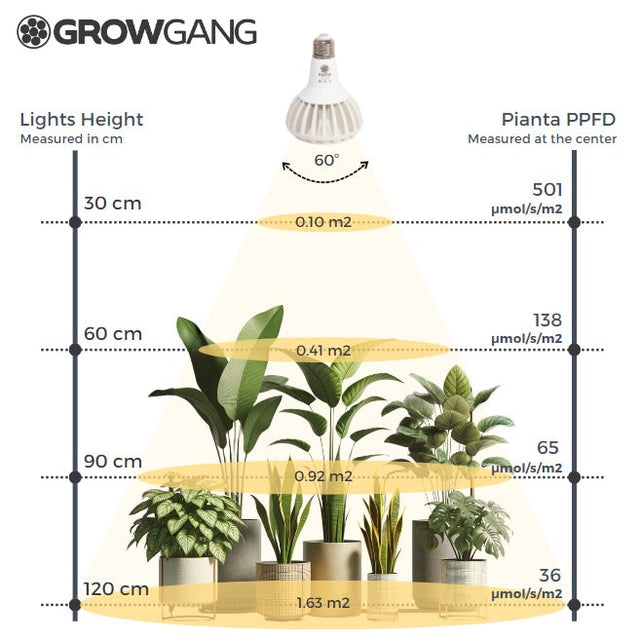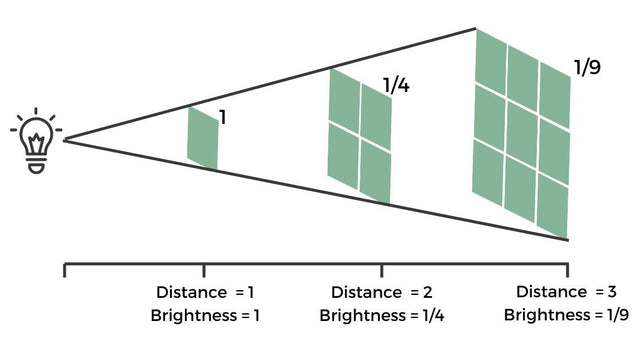Introduction to Grow Lights
Grow lights are essential tools for indoor gardening, enabling plants to thrive even in environments lacking natural sunlight. These lights replicate the spectrum of the sun, offering a substitute that helps photosynthesis continue indoors. Understanding the types of grow lights available and their respective advantages will allow gardeners to make informed decisions best suited to their plant's needs.
🔆 Key Takeaway: Grow lights are indispensable for indoor gardening, providing vital energy that helps plants grow healthy and strong. Ensure to choose a light type that suits your specific plant requirements.
Types of Grow Lights
Each type of grow light offers unique benefits and limitations, which are crucial to consider when setting up an indoor garden. Knowing these can help maximise your plant's growth potential and ensure energy efficiency.
- Incandescent Lights
- Relatively cheap to buy
- Not Very efficient, and high running costs
- Generates a lot of heat, which might not be suitable for all plants
- HID Grow Lights
- Knows for their higher efficiency and intensity than incandescent, making them popular for large-scale horticulture.
- Produce significant heat, requiring good ventilation to prevent plant damage.
- Typically more expensive initially but provide excellent light penetration for deeper canopies.
- HPS Grow Lights
- Particularly favoured during the flowering stage of plant growth due to their red-orange light spectrum.
- More efficient than incandescent light.
- Emit a lot of heat and may also require additional cooling systems.
- Fluorescent Lights (and CFL - Compact fluorescent)
- Ideal for herbs and starting seedlings.
- Less heat output compared to incandescent, HID and HPS.
- Available in tubes or compact bulbs.
- LED Grow Lights
- Most energy-efficient option
- Supports a full spectrum, beneficial for all growth stages, but also possible to get them in specific spectrums and light ranges.
- Longer lifespan, reducing replacement costs.
🔆 Opinion and key takeaway: We believe that with the development of LED technology for most use cases LED grow lights will be the best option. They offer very significant energy savings, don’t emit as much heat and have much longer lifespans. Did you know that for regular household lighting incandescent and fluorescent lights are being phased out in many countries due to their inefficiency and environmental harm.
Optimal Light Spectrum for Plant Growth
The light spectrum your grow lights provide can significantly impact how well your plants perform photosynthesis. Different colours in the light spectrum influence various growth processes, such as flowering and root development.
- Blue Light: Essential for vegetative growth; encourages strong leaves and stems.
- Red Light: Promotes flowering and fruit production.
- Combination of Red and Blue: Giving off a purple colour, this used to be quite popular as the Blue and Red spectrum promotes growth and flowering, and these wavelengths are the most efficient for photosynthesis.
- Full Spectrum: This is a more balanced light that mimics the suns light giving off a white colour. More recent reasearch points to this being most beneficial for a number of reasons:
- The green light that is included in the full spectrum is transmitted deeper into the leaves, and is more efficient at driving CO2 fixation on the lower sides of the leaf even though green light is poorly absorbed by the plants.
- Full spectrum lights also look a lot better in living areas, and the balanced light makes it much easier to spot pests early.

🔆 Key Takeaway: Effective indoor gardening requires not just any light, but the right spectrum. Blue and red lights play crucial roles, and the green part of the spectrum also have many benefits. Many advanced grow lights, like the Pianta Grow Light, (or AC infinity for more commercial set ups) combine these parts of the spectrum for optimal effect.
Setting Up Your Indoor Garden with Grow Lights
Proper setup of grow lights is as vital as the type of light used. Positioning, space, and timing all play crucial roles in your indoor garden’s success.
- Space Utilisation: Ensure plants are spaced to receive even light distribution, be mindful that plants on the edge of the grow area may receive a lower light intensity.
- Light Placement: Lights should be close enough to deliver direct light but far enough to prevent heat damage.
- Timing: Using a timer, like the Tempo Plug-in Smart Timer, can help regulate light exposure, ensuring plants get the right amount of light consistently.
🔆 Key Takeaway: Setting up grow lights properly involves more than just turning them on. Positioning them correctly and timing their exposure ensures your plants receive the maximum benefit without any risk of light burn or energy waste, a little bit of trial and error is needed here to get the best results.
Effective Grow Light Scheduling and Plant Health
For indoor plants, the duration and timing of light exposure are just as important as the quality of light they receive. This section explores how to manage light cycles and the significance of dark periods for plant health.
- Determining Light Duration: The necessary light duration varies by plant species, with most requiring between 12-16 hours of light per day. (however if you already have some natural light grow lights can be great for giving your plants a boost for a few hours a day.)
- Importance of Darkness: Plants also need dark periods to process nutrients and rest, mimicking natural day-night cycles.
- Using Timers: To ensure consistency, tools like the Tempo Plug-in Smart Timer can automate light cycles, making it easier to provide plants with a stable environment conducive to growth.

🔆 Key Takeaway: Managing the light schedule of your indoor garden is crucial for maintaining healthy plant growth. Incorporating periods of darkness alongside adequate daylight hours can significantly impact their development and make them thrive.
Comparing Grow Light Output and Technical Specifications
Understanding the output and technical specifications of grow lights can help in optimising indoor plant growth and choosing the right grow light. You may have seen many different terms and abbreviations mentioned. This section should help clear things up and help you compare different grow lights based on their power, efficiency, and suitability for various plant types.
- Lumens : Total amount of visible light emitted by a source, it represents the human eyes perception of light intensity. We generally wouldn’t recommend using this for grow lights, however it can give you a great rough idea of the light intensity for plants if no other metrics are available.
- PAR (Photosynthetically active radiation) : Is the range of light most important for plants photosynthesis.
- PPF (Photosynthetic Photon Flux): Is a measure of the total useful light for photosynthesis that is emitted. This measure is good for comparing grow lights total output.
- PPF/W: Is a measure of the efficiency of the grow light, the PPF divided by the watts used. Considering PPF/W is crucial because a light with a high total PPF might seem effective but could be inefficient if it also consumes a lot of power. Thus, PPF/W helps you compare the energy efficiency of grow lights, ensuring that you're not only getting a powerful light but one that uses energy economically.
- PPFD: Is a measure of the intensity of useful light for photosynthesis at a particular distance from your plants. A PPFD reading always needs to be accompanied by a distance, the distance from the grow light that the reading is taken.
- This measurement is most useful when setting up your plants and grow lights, and making sure they are getting enough light, as light intensity drops off quickly as the distance increases for any grow light or light source. Many grow lights show a graph of PPFD measurements at different distances. It is easy to get this confused with PPF but be careful, as they are different metrics!
🔆 Key Takeaway: When choosing grow lights, it's not just about the type of light; the output and technical specifics such as PPF, PPFD and wattage play significant roles. Understanding these can lead to better energy management and enhanced plant growth. This knowledge helps in selecting the most appropriate lights for specific gardening goals, ensuring that your plants receive the optimal light they require. Explore these concepts in depth in our comprehensive guide to grow light terminology.
Choosing the Right Grow Light for Your Needs
Selecting the right grow light involves considering various factors, including the types of plants you have, the size of your indoor garden, and your budget.
- Plant Type: Different plants have different light needs; tailor your choice to match, are your plants light hungry, or can they tolerate lower light conditions?
- Indoor Garden Size: Larger spaces may require more powerful lighting solutions or multiple units.
- Budget: Balance your spending between initial costs and long-term energy savings. Remember that going for the cheapest option may be more expensive in the long run, if the efficiency is low (PPF/W can be a good way to measure this.)
🔆 Key Takeaway: The right grow light for your indoor garden enhances plant growth and optimises your energy usage. Consider all factors carefully to choose a light that meets both your garden's needs and your economic priorities.
Conclusion
Grow lights are pivotal in the success of indoor gardening. They compensate for the lack of natural sunlight, providing the necessary spectrum and intensity of light needed for various plant processes.
Find similar articles:
Using Grow LightsMentioned in this article
More stories

What is the PPFD of the Pianta Grow Light?

